Don’t Miss Out on the Latest Updates.
Subscribe to Our Newsletter Today!
The massive muscle anatomy and body building guide you always wanted!
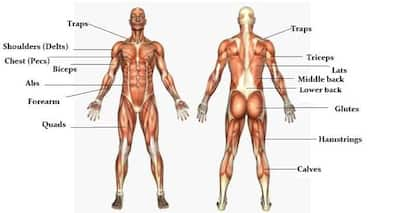
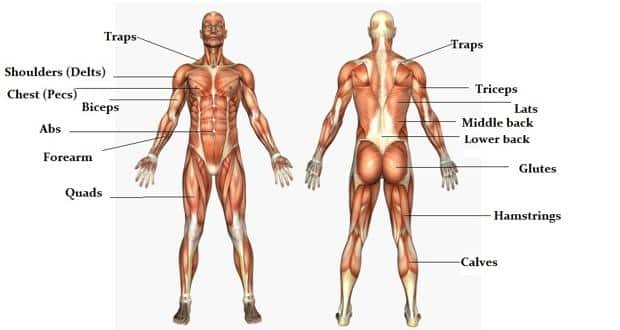 Strength training isn't a mindless jock activity. Athletes, trainers, bodybuilders and even regular gym-goers need to understand exactly how the muscles in their body function, so that they can work them properly to make them stronger and bigger. Each muscle serves a different purpose and the aim of exercising shouldn't simply be to make them aesthetically-pleasing but to make sure each and every muscle in your body is strong.
Strength training isn't a mindless jock activity. Athletes, trainers, bodybuilders and even regular gym-goers need to understand exactly how the muscles in their body function, so that they can work them properly to make them stronger and bigger. Each muscle serves a different purpose and the aim of exercising shouldn't simply be to make them aesthetically-pleasing but to make sure each and every muscle in your body is strong.
The muscles of your body which you can work out can broadly be divided into two categories upper body and lower body muscles. In the upper body muscles you have shoulder (deltoids and traps), back (lats, middle back and lower back), arms (biceps, triceps and forearms), chest (major and minor pectoralis) and abdomen muscles. In the lower body muscles you've glutes, quads, hamstrings and calves.
Now each of these muscles have separate isolation exercises to target that particular muscle and compound exercises which targets more than one muscle group and joint. We will first start off explaining what each muscle group does for the human body:
Also Read
Upper body muscles
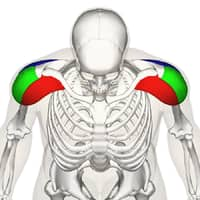 Shoulders
Shoulders
Deltoids At the top of your shoulder are the deltoids, popularly called delts. They can be divided into anterior, middle and posterior delts. The deltoids are muscles which help in abduction (pull away from axis), rotation and flexing.
Dumbbell shoulder press
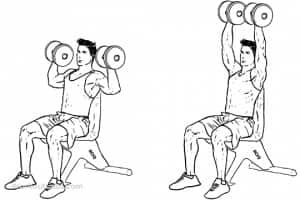 Holding a dumbbell in each hand, sit on a military press bench or utility bench with back support. Place the dumbbells upright on top of your thighs. Raise the dumbbells to shoulder height one at a time, using your thighs to help propel them into position. Be sure to rotate your wrists so that the palms of your hands are facing forward. This is your starting position. Exhale as you push the dumbbells upward until they almost touch at the top. After a brief pause at the top, inhale as you slowly lower the weights to the starting position.
Holding a dumbbell in each hand, sit on a military press bench or utility bench with back support. Place the dumbbells upright on top of your thighs. Raise the dumbbells to shoulder height one at a time, using your thighs to help propel them into position. Be sure to rotate your wrists so that the palms of your hands are facing forward. This is your starting position. Exhale as you push the dumbbells upward until they almost touch at the top. After a brief pause at the top, inhale as you slowly lower the weights to the starting position.
Side dumbbell raise
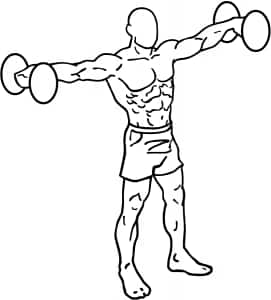 Stand up straight with a dumbbell in each hand at your sides, your palms facing you. This will be your starting position. With your torso stationary, exhale as you lift the dumbbells to your sides with a slight bend in your elbows, continuing to raise the weights until your arms are parallel to the floor. Your hands should be tilted slightly forward as if you are pouring a glass of water. Pause for a brief moment at the top, then inhale as you slowly lower the weights to the starting position.
Stand up straight with a dumbbell in each hand at your sides, your palms facing you. This will be your starting position. With your torso stationary, exhale as you lift the dumbbells to your sides with a slight bend in your elbows, continuing to raise the weights until your arms are parallel to the floor. Your hands should be tilted slightly forward as if you are pouring a glass of water. Pause for a brief moment at the top, then inhale as you slowly lower the weights to the starting position.
Dumbbell front raise
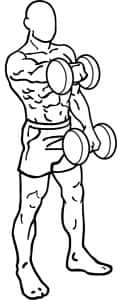 Stand up straight with a dumbbell in each hand in front of your thighs at arms' length, using an overhand grip. This will be your starting position. Without swinging, lift the right dumbbell to the front with a slight bend in your elbow with your palm facing down. Continue to lift it until your arm is slightly above your chest, and parallel to the floor. Lower the dumbbell slowly to the starting position, then repeat with the left dumbbell. Continue alternating in this fashion until the recommended number of reps has been performed with each arm.
Stand up straight with a dumbbell in each hand in front of your thighs at arms' length, using an overhand grip. This will be your starting position. Without swinging, lift the right dumbbell to the front with a slight bend in your elbow with your palm facing down. Continue to lift it until your arm is slightly above your chest, and parallel to the floor. Lower the dumbbell slowly to the starting position, then repeat with the left dumbbell. Continue alternating in this fashion until the recommended number of reps has been performed with each arm.
Bent-over rear raise
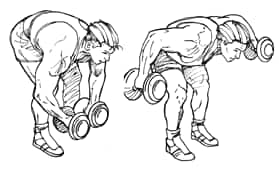 Keeping your back straight, bend at the waist to pick up two dumbbells, your palms facing behind you. This will be your starting position. Keeping your torso stationary, exhale as you lift the dumbbells straight to your sides until your upper arms are parallel to the floor. Pause briefly at the contracted position, then inhale as you slowly lower the dumbbells to the starting position.
Keeping your back straight, bend at the waist to pick up two dumbbells, your palms facing behind you. This will be your starting position. Keeping your torso stationary, exhale as you lift the dumbbells straight to your sides until your upper arms are parallel to the floor. Pause briefly at the contracted position, then inhale as you slowly lower the dumbbells to the starting position.
Push-ups (Works the delts, abs, pecs and triceps)
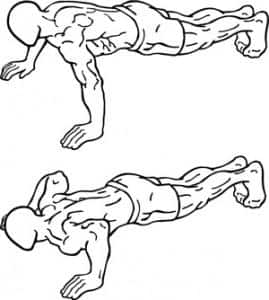 Get down on all fours and place your hands a little wider than your shoulders. Keep your feet together and strengthen your arms and legs. Make sure that your entire body is in one straight line, from head to toe. Keeping your elbows close, lower your chest till it's just one inch above the floor. Hold this position for a second and bring your body up. Read more about push-ups and the different varieties.
Get down on all fours and place your hands a little wider than your shoulders. Keep your feet together and strengthen your arms and legs. Make sure that your entire body is in one straight line, from head to toe. Keeping your elbows close, lower your chest till it's just one inch above the floor. Hold this position for a second and bring your body up. Read more about push-ups and the different varieties.
Back
The back muscles can be divided into traps, middle back (rhomboids), lats and lower back.
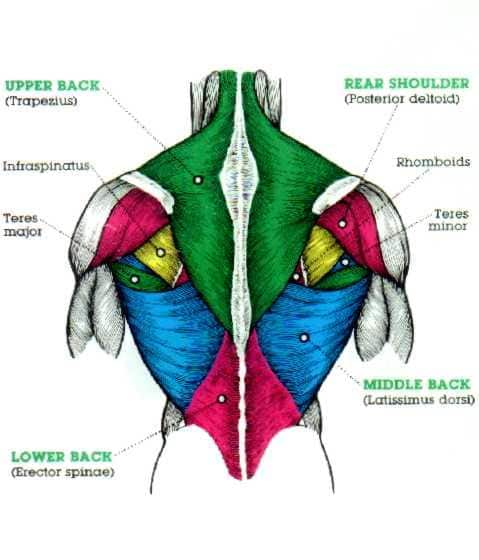 Traps Now the traps or trapezius muscle connects the deltoids to the back which supports the weight of your arm and retracts and rotates the (scapulae) shoulder blades.
Traps Now the traps or trapezius muscle connects the deltoids to the back which supports the weight of your arm and retracts and rotates the (scapulae) shoulder blades.
Middle back (Rhomboids) The rhomboids helps you squeeze the shoulder blades together and provide stability to the shoulder.
Lats (Latissimus dorsi muscle) The lats help you pull your arm down and back and keep your elbow close.
Lower back Thelower back muscles are necessary to stabilise your spine and part of the core muscles.
Pull-ups (Targets all the back muscles)
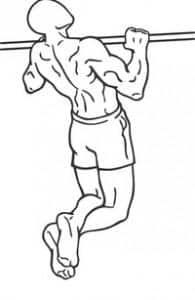 The pull-up is a great compound exercise to work your back and in fact your total upper body. In order to do a pull-up, you need to stand straight with your arms fully extended and gripping the pull-up bar. Then, as the name of the exercise suggests, pull-up until your chin is above the bar. Now, release the pressure you've exerted on your muscles and come down slowly until your arms are once again fully extended.
The pull-up is a great compound exercise to work your back and in fact your total upper body. In order to do a pull-up, you need to stand straight with your arms fully extended and gripping the pull-up bar. Then, as the name of the exercise suggests, pull-up until your chin is above the bar. Now, release the pressure you've exerted on your muscles and come down slowly until your arms are once again fully extended.
Deadlift (Entire back, chest, hips, hamstrings, quadriceps, abs, biceps, legs, hips and abs)
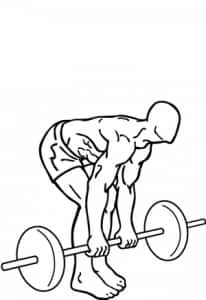 The deadlift remains one of the most popular bodybuilding exercises of all time. It's a compound exercise that works your entire back. Your starting position will be feet, shoulder width apart. Bend your knees to reach down and grab the bar without bending over. Lift the bar with your hands slightly lesser than shoulder width (markings on the bar will indicate where you should hold). Now raise the bar slowly till the hip level and then bring it back to your shin. Remember you are supposed to lift the bar using your legs, hips and other muscles and not your arms.
The deadlift remains one of the most popular bodybuilding exercises of all time. It's a compound exercise that works your entire back. Your starting position will be feet, shoulder width apart. Bend your knees to reach down and grab the bar without bending over. Lift the bar with your hands slightly lesser than shoulder width (markings on the bar will indicate where you should hold). Now raise the bar slowly till the hip level and then bring it back to your shin. Remember you are supposed to lift the bar using your legs, hips and other muscles and not your arms.
Two-seated cable row (Entire back, biceps and triceps)
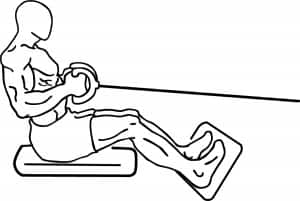 Sit bent slightly forward on a seat or a bench and grasp the cable attachment and place your feet on the vertical platform while you keep your hips, back and knees slightly bent. Pull the cable attachment to your waist while you push your chest forward while arching your back. Return to the original position until arms are extended and shoulders and lower back flexed forward. Repeat it.
Sit bent slightly forward on a seat or a bench and grasp the cable attachment and place your feet on the vertical platform while you keep your hips, back and knees slightly bent. Pull the cable attachment to your waist while you push your chest forward while arching your back. Return to the original position until arms are extended and shoulders and lower back flexed forward. Repeat it.
T-bar (Middle back, biceps and shoulders)
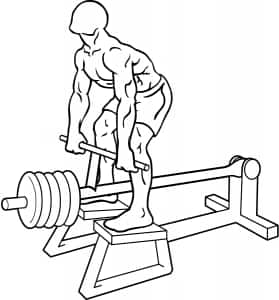 The T-bar is a machine that's present in most gyms. It usually has two platforms for your legs and a long bar with two small handles. It will be easy to spot. Keep your feet firmly on the ground and using a narrow grip, hold the bar slightly off the ground while keeping your back straight and knees bent. Lift the bar towards your body with your back while squeezing the shoulder blades together. Lift the bar until it almost touches your lower chest and repeat the exercise.
The T-bar is a machine that's present in most gyms. It usually has two platforms for your legs and a long bar with two small handles. It will be easy to spot. Keep your feet firmly on the ground and using a narrow grip, hold the bar slightly off the ground while keeping your back straight and knees bent. Lift the bar towards your body with your back while squeezing the shoulder blades together. Lift the bar until it almost touches your lower chest and repeat the exercise.
Expert tip: Make sure your back is not arched while doing this exercise. Try and stay in the bent knees position throughout the exercise and don't move your lower bod
Bent over dumbbell rows (Lats, biceps and shoulders)
Start with a dumbbell in each hand. Bend your knees slightly and bring your torso forward. Keeping your back straight and head up, bend at the hips until you are nearly parallel to the floor. The weights should hang directly in front of you; your arms will be perpendicular to the floor. This is your starting position. Keeping your torso stationary, lift the dumbbells to your sides as you exhale, keeping your elbows close to your body. As you pull, squeeze your shoulders back and hold for a brief pause. Inhale as you slowly lower the weights back to the starting position.
One-arm dumbbell rows (Lats, traps and biceps)
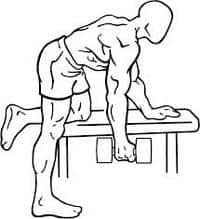 Say you start with your right arm. Keep your left knee and left hand on the bench and the right on the ground. Keep your face straight and back arched. Pull your shoulder blade back while keeping your arm straight and pull the dumbbell as far up as possible and then slowly lower the dumbbell. After you've done the desired numbers of reps, switch sides. Always look straight while performing this exercise as this will help keep the back straight. Keep the upper half of your body completely fixed while doing this and don't let your shoulder drop. Make sure you're pulling using your back muscles and not your forearm.
Say you start with your right arm. Keep your left knee and left hand on the bench and the right on the ground. Keep your face straight and back arched. Pull your shoulder blade back while keeping your arm straight and pull the dumbbell as far up as possible and then slowly lower the dumbbell. After you've done the desired numbers of reps, switch sides. Always look straight while performing this exercise as this will help keep the back straight. Keep the upper half of your body completely fixed while doing this and don't let your shoulder drop. Make sure you're pulling using your back muscles and not your forearm.
Dumbbell shrugs
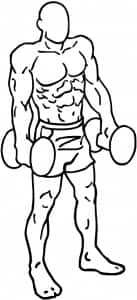 Stand erect with a dumbbell in each hand with your arms at your sides, your palms facing your torso. This will be your starting position. Exhale as you raise the dumbbells as high as possible by elevating your shoulders; keep your arms extended at all times and move only your shoulders up and down. Hold the contracted position for one second, then inhale as you slowly lower the dumbbells back to the starting position.
Stand erect with a dumbbell in each hand with your arms at your sides, your palms facing your torso. This will be your starting position. Exhale as you raise the dumbbells as high as possible by elevating your shoulders; keep your arms extended at all times and move only your shoulders up and down. Hold the contracted position for one second, then inhale as you slowly lower the dumbbells back to the starting position.
Lateral pull down (Lats, biceps and shoulders)
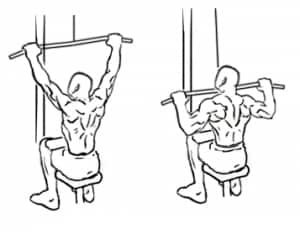 Attach a wide bar to the top pulley of a pull-down machine and sit down, adjusting the knee pad to fit snugly against your legs. Grip the bar wide with the palms of your hands facing away from your body. Lean your torso back slightly to create a small curvature in your back and stick your chest out. This will be your starting position. Exhale and bring the bar down until it touches your upper chest. As you pull the bar down, squeeze your shoulder blades back and down. Your upper torso should remain stationary during the movement, and only your arms should move. After a brief pause at the bottom, contracted position, inhale as you slowly raise the bar back to the starting position with your arms fully extended, feeling a slight stretch in your lats. Make sure you don't lock your head and neck which can lead to stiffness and also that you're not straining your spine while doing this exercise.
Attach a wide bar to the top pulley of a pull-down machine and sit down, adjusting the knee pad to fit snugly against your legs. Grip the bar wide with the palms of your hands facing away from your body. Lean your torso back slightly to create a small curvature in your back and stick your chest out. This will be your starting position. Exhale and bring the bar down until it touches your upper chest. As you pull the bar down, squeeze your shoulder blades back and down. Your upper torso should remain stationary during the movement, and only your arms should move. After a brief pause at the bottom, contracted position, inhale as you slowly raise the bar back to the starting position with your arms fully extended, feeling a slight stretch in your lats. Make sure you don't lock your head and neck which can lead to stiffness and also that you're not straining your spine while doing this exercise.
Reverse grip pull-down (Lats, biceps and shoulders)
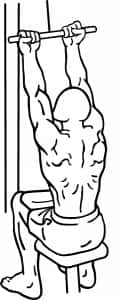 Attach a wide or cambered bar to the top pulley of a pulldown machine and sit down, adjusting the knee pad to fit snugly against your legs. Grab the pulldown bar with your palms facing your torso. Make sure that your hands are about shoulder width apart. Lean your torso back slightly to create a small curvature in your back and stick out your chest. This is your starting position. Now, as you exhale, pull the bar down until it touches your upper chest by drawing your shoulders and upper arms down and back. Focus on squeezing your back muscles once you reach the fully contracted position, keeping your elbows close to your body. Your upper torso should remain stationary during the movement, and only your arms should move. After a brief pause at the bottom, contracted position, inhale as you slowly raise the bar to the starting position with your arms fully extended, feeling a slight stretch in your lats.
Attach a wide or cambered bar to the top pulley of a pulldown machine and sit down, adjusting the knee pad to fit snugly against your legs. Grab the pulldown bar with your palms facing your torso. Make sure that your hands are about shoulder width apart. Lean your torso back slightly to create a small curvature in your back and stick out your chest. This is your starting position. Now, as you exhale, pull the bar down until it touches your upper chest by drawing your shoulders and upper arms down and back. Focus on squeezing your back muscles once you reach the fully contracted position, keeping your elbows close to your body. Your upper torso should remain stationary during the movement, and only your arms should move. After a brief pause at the bottom, contracted position, inhale as you slowly raise the bar to the starting position with your arms fully extended, feeling a slight stretch in your lats.
Hyperextension (Lower back, glutes and hamstrings)
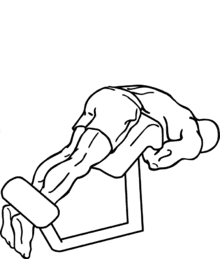 This is a back exercise which is usually done with a piece of equipment called the Roman Chair also called a hyperextension bench. Most gyms have this equipment; it's basically an inclined gym bench with platforms to lock your legs in some gyms it's also called the hyperextension bench.
This is a back exercise which is usually done with a piece of equipment called the Roman Chair also called a hyperextension bench. Most gyms have this equipment; it's basically an inclined gym bench with platforms to lock your legs in some gyms it's also called the hyperextension bench.
Just lie down face forward on the bench and lock your ankles properly. You can either cross your hands around your chest or keep them behind your head. Bend over as far as you can while keeping your back straight and then come back to the original position.When coming up make sure you don't go beyond the point where your back is straight.
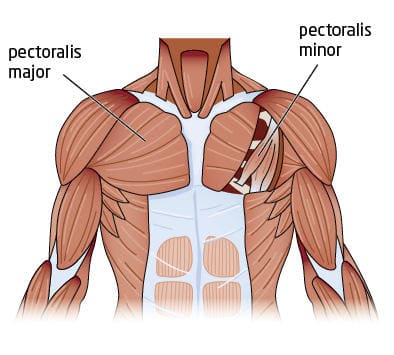 ChestThe chest muscles consist of pectoralis major and minor which helps you pull the arm down and in towards the body and also allows you to put your arm ahead.
ChestThe chest muscles consist of pectoralis major and minor which helps you pull the arm down and in towards the body and also allows you to put your arm ahead.
Exercises for the chest muscles There are various different kinds of exercises
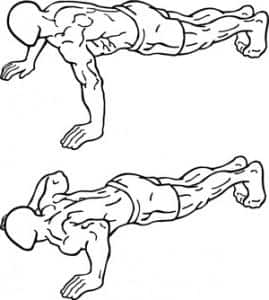 Get down on all fours and place your hands a little wider than your shoulders. Keep your feet together and strengthen your arms and legs. Make sure that your entire body is in one straight line, from head to toe. Keeping your elbows close, lower your chest till it's just one inch above the floor. Hold this position for a second and bring your body up. Read more about push-ups and the different varieties.
Get down on all fours and place your hands a little wider than your shoulders. Keep your feet together and strengthen your arms and legs. Make sure that your entire body is in one straight line, from head to toe. Keeping your elbows close, lower your chest till it's just one inch above the floor. Hold this position for a second and bring your body up. Read more about push-ups and the different varieties.
Barbell bench press
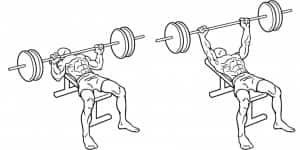 Lie back on a flat bench. Using a medium-wide grip, lift the bar from the rack and hold it straight over you with your arms locked. This will be your starting position. From the starting position, bring the bar down slowly till it slightly touches your middle chest. Hold this position for a while and then push back to the starting position while breathing out. This will be one rep. Repeat for desired number of repetitions.
Lie back on a flat bench. Using a medium-wide grip, lift the bar from the rack and hold it straight over you with your arms locked. This will be your starting position. From the starting position, bring the bar down slowly till it slightly touches your middle chest. Hold this position for a while and then push back to the starting position while breathing out. This will be one rep. Repeat for desired number of repetitions.
Tips: Make sure you breathe properly while doing this exercise. Lower the weight slowly and make sure you just touch your chest. You should have complete control over the bar at all times. If you've never done this exercise, use a spotter or floor trainer to keep an eye.
Dumbbell bench press
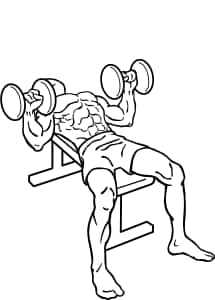 Lie on a flat bench with a dumbbell in each hand resting on top of your thighs, the palms of your hands facing each other. Using your thighs to help raise the dumbbells, lift them one at a time until you are holding them in front of you, shoulder-width apart. Rotate your wrists forward so that the palms of your hands are facing your lower body. The dumbbells should be just to the sides of your chest, with your upper arms and forearms creating a 90-degree angle. This will be your starting position. Exhale as you use your chest to push the dumbbells up. Lock your arms at the top and squeeze your chest, then inhale as you return to the starting position.
Lie on a flat bench with a dumbbell in each hand resting on top of your thighs, the palms of your hands facing each other. Using your thighs to help raise the dumbbells, lift them one at a time until you are holding them in front of you, shoulder-width apart. Rotate your wrists forward so that the palms of your hands are facing your lower body. The dumbbells should be just to the sides of your chest, with your upper arms and forearms creating a 90-degree angle. This will be your starting position. Exhale as you use your chest to push the dumbbells up. Lock your arms at the top and squeeze your chest, then inhale as you return to the starting position.
Incline bench press
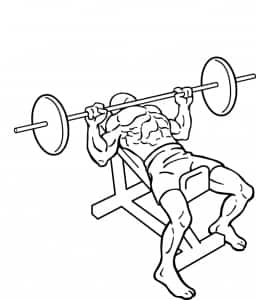 Lie on an incline bench with a dumbbell in each hand on top of your thighs, palms facing each other. Using your knees to help bring the dumbbells up, hold them out to the sides with your elbows bent at about 90 degrees, your palms facing toward your lower body. This will be your starting position. Exhale as you extend your arms and bring the dumbbells together above your head so that your arms are perpendicular to the floor. After a brief pause, inhale as you return the dumbbells to the starting position.
Lie on an incline bench with a dumbbell in each hand on top of your thighs, palms facing each other. Using your knees to help bring the dumbbells up, hold them out to the sides with your elbows bent at about 90 degrees, your palms facing toward your lower body. This will be your starting position. Exhale as you extend your arms and bring the dumbbells together above your head so that your arms are perpendicular to the floor. After a brief pause, inhale as you return the dumbbells to the starting position.
Dumbbell flyes
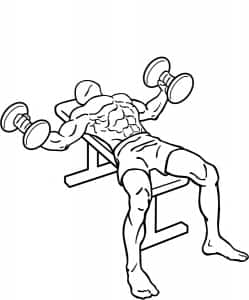 Lie down on a flat bench with a dumbbell in each arm. The palms of your arm will be inwards, facing one another. Hold the dumbbells perpendicular to your chest up with a slight bend in your elbow. This will be your starting position. Lower your arms on both sides creating a wide arc until you feel a slight stretch over your chest. Make sure your arms remain stationary while doing this and the movement is powered by the shoulder joint. Return to the starting position as you squeeze your chest muscles and breathe out. This is one complete set. Hold this position for a second and repeat the desired the number of times.
Lie down on a flat bench with a dumbbell in each arm. The palms of your arm will be inwards, facing one another. Hold the dumbbells perpendicular to your chest up with a slight bend in your elbow. This will be your starting position. Lower your arms on both sides creating a wide arc until you feel a slight stretch over your chest. Make sure your arms remain stationary while doing this and the movement is powered by the shoulder joint. Return to the starting position as you squeeze your chest muscles and breathe out. This is one complete set. Hold this position for a second and repeat the desired the number of times.
Incline dumbbell flyes
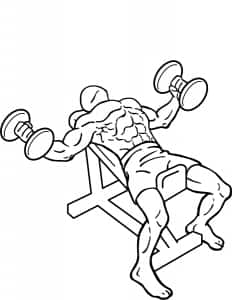 Lie on an incline bench with a dumbbell in each hand on top of your thighs, palms facing each other. Using your knees to help bring the dumbbells up, hold them out to the sides with your elbows bent at about 90 degrees, your palms facing toward your lower body. This will be your starting position. Exhale as you extend your arms and bring the dumbbells together above your head so that your arms are perpendicular to the floor. After a brief pause, inhale as you return the dumbbells to the starting position.
Lie on an incline bench with a dumbbell in each hand on top of your thighs, palms facing each other. Using your knees to help bring the dumbbells up, hold them out to the sides with your elbows bent at about 90 degrees, your palms facing toward your lower body. This will be your starting position. Exhale as you extend your arms and bring the dumbbells together above your head so that your arms are perpendicular to the floor. After a brief pause, inhale as you return the dumbbells to the starting position.
Straight Arm Dumbbell Pullovers
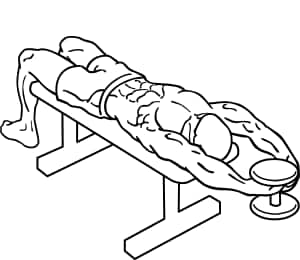 Place a dumbbell standing up on a flat bench. To ensure that the dumbbell stays securely placed at the top of the bench, lie perpendicular along the bench with only your shoulders on the surface. With your knees bent and your feet firmly on the floor, drop your hips just slightly below the level of the bench. Your head will be off the bench as well. Grasp the dumbbell with both hands and extend your arms up above your chest; your palms should be pressing against the underside of the dumbbell plate. This will be your starting position. Keeping your arms straight, inhale as you slowly lower the weight in an arc behind your head until you feel a stretch in your chest. Exhale as you return the dumbbell to the starting position following the same arc. Hold the weight at the top for a moment once you have returned it to the starting position.
Place a dumbbell standing up on a flat bench. To ensure that the dumbbell stays securely placed at the top of the bench, lie perpendicular along the bench with only your shoulders on the surface. With your knees bent and your feet firmly on the floor, drop your hips just slightly below the level of the bench. Your head will be off the bench as well. Grasp the dumbbell with both hands and extend your arms up above your chest; your palms should be pressing against the underside of the dumbbell plate. This will be your starting position. Keeping your arms straight, inhale as you slowly lower the weight in an arc behind your head until you feel a stretch in your chest. Exhale as you return the dumbbell to the starting position following the same arc. Hold the weight at the top for a moment once you have returned it to the starting position.
Arms Biceps, Triceps and Forearms
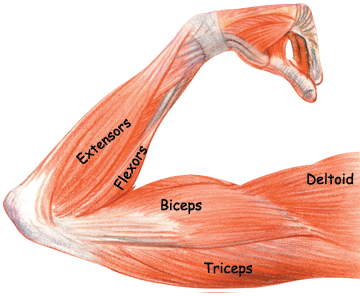 The arms can be divided into three separate muscle groups biceps, triceps and forearms. Each of these has what are called extensors (muscles which help extend the arm and increase the angle of the joint) and flexors (muscles which help flex the arm and decrease the angle of the joint).
The arms can be divided into three separate muscle groups biceps, triceps and forearms. Each of these has what are called extensors (muscles which help extend the arm and increase the angle of the joint) and flexors (muscles which help flex the arm and decrease the angle of the joint).
Hammer
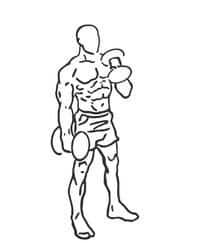 Stand straight while holding a dumbbell in each of your arms. Your palms should be facing in. Slowly raise the dumbbell until the forearm is completely vertical and then lower your arm to the original position. Do the lifting with your elbows and not your wrists. Keep the wrist as firm as possible.
Stand straight while holding a dumbbell in each of your arms. Your palms should be facing in. Slowly raise the dumbbell until the forearm is completely vertical and then lower your arm to the original position. Do the lifting with your elbows and not your wrists. Keep the wrist as firm as possible.
Barbell curl
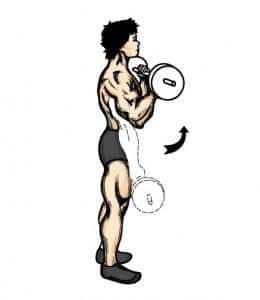 Stand up straight holding a barbell with a shoulder-width grip. The palms of your hands should be facing away from your body and your elbows should be close to your torso. This will be your starting position. Exhale and curl the barbell upward by contracting your biceps. Be sure to keep your upper arms stationary; continue raising the barbell until it reaches shoulder level. Hold the contracted position for a brief moment. Inhale as you slowly lower the bar to the starting position.
Stand up straight holding a barbell with a shoulder-width grip. The palms of your hands should be facing away from your body and your elbows should be close to your torso. This will be your starting position. Exhale and curl the barbell upward by contracting your biceps. Be sure to keep your upper arms stationary; continue raising the barbell until it reaches shoulder level. Hold the contracted position for a brief moment. Inhale as you slowly lower the bar to the starting position.
Preacher curl
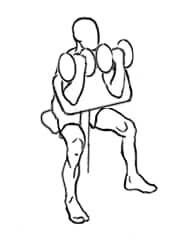 Position yourself on the preacher bench with a dumbbell in your left hand, your palm facing up. With your upper arms and chest positioned against the preacher bench pad, hold the dumbbell at shoulder level. This will be your starting position. Inhale as you slowly lower the weight until your arm is almost fully extended. Exhale, using your biceps muscle to curl the weight back up until your arm is fully contracted at the starting position. Squeeze the biceps and hold for a brief moment at the contracted position to get the maximum benefit. Once you have completed the exercise with the left arm, do the same with the right.
Position yourself on the preacher bench with a dumbbell in your left hand, your palm facing up. With your upper arms and chest positioned against the preacher bench pad, hold the dumbbell at shoulder level. This will be your starting position. Inhale as you slowly lower the weight until your arm is almost fully extended. Exhale, using your biceps muscle to curl the weight back up until your arm is fully contracted at the starting position. Squeeze the biceps and hold for a brief moment at the contracted position to get the maximum benefit. Once you have completed the exercise with the left arm, do the same with the right.
Concentration curl
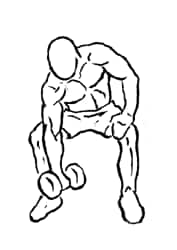 Sit on the edge of the bench. Use your right arm to pick the dumbbell up and place the back your upper left arm on the top of your left thigh. Rotate the palm of your hand until it's facing away from the thigh. Extend your arm so that the dumbbell is just above the floor. This is your starting position. Curl the dumbbell while contracting your biceps as you breathe out. Make sure your upper arm is stationary. Continue this movement until the dumbbell reaches your shoulders, hold the positions for a second and then return to the starting position. This is one rep. Do the desired number of the sets. And then repeat with the left hand.
Sit on the edge of the bench. Use your right arm to pick the dumbbell up and place the back your upper left arm on the top of your left thigh. Rotate the palm of your hand until it's facing away from the thigh. Extend your arm so that the dumbbell is just above the floor. This is your starting position. Curl the dumbbell while contracting your biceps as you breathe out. Make sure your upper arm is stationary. Continue this movement until the dumbbell reaches your shoulders, hold the positions for a second and then return to the starting position. This is one rep. Do the desired number of the sets. And then repeat with the left hand.
Cable curls
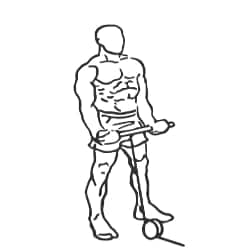 Attach a cable curl bar to a low pulley and stand facing the machine. Grab the cable bar with your palms facing up, keeping your hands shoulder width apart and your elbows close to your torso. This will be your starting position. Keeping your upper arms stationary, exhale as you curl the weights upward, contracting the biceps. Only your forearms should move. Continue to raise the weights until your biceps are fully contracted and the bar is at shoulder level. Hold the contracted position for a brief moment. Inhale as you slowly lower the bar to the starting position.
Attach a cable curl bar to a low pulley and stand facing the machine. Grab the cable bar with your palms facing up, keeping your hands shoulder width apart and your elbows close to your torso. This will be your starting position. Keeping your upper arms stationary, exhale as you curl the weights upward, contracting the biceps. Only your forearms should move. Continue to raise the weights until your biceps are fully contracted and the bar is at shoulder level. Hold the contracted position for a brief moment. Inhale as you slowly lower the bar to the starting position.
Exercises for Triceps
Bench Dips
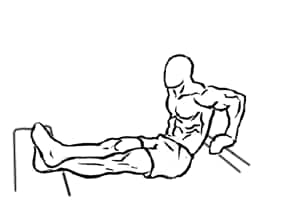 Place a bench behind you and with the bench perpendicular to your body and sit down Lower yourself to the ground while using your palms to support your body. Keep your arms wide, but not too wide (only shoulder-wide) and extend your legs forward and perpendicular to the torso. This is the starting position. Slowly lower your body by bending the elbows until your forearm and upper arm are almost perpendicular. Make sure elbows are close and forearm is pointing down. Raise yourself using your triceps muscles, to bring your torso again and return to the starting position. Keep your back as close to the bench as possible. Don't bend your knees as this will make the exercise easier and put less pressure on your triceps muscles. This exercise can be made tougher by doing it on two benches, one to support your hands and another one for your legs. When you get used to that variation as well, you can use plates or weights on top your lap to increase the challenges.
Place a bench behind you and with the bench perpendicular to your body and sit down Lower yourself to the ground while using your palms to support your body. Keep your arms wide, but not too wide (only shoulder-wide) and extend your legs forward and perpendicular to the torso. This is the starting position. Slowly lower your body by bending the elbows until your forearm and upper arm are almost perpendicular. Make sure elbows are close and forearm is pointing down. Raise yourself using your triceps muscles, to bring your torso again and return to the starting position. Keep your back as close to the bench as possible. Don't bend your knees as this will make the exercise easier and put less pressure on your triceps muscles. This exercise can be made tougher by doing it on two benches, one to support your hands and another one for your legs. When you get used to that variation as well, you can use plates or weights on top your lap to increase the challenges.
One-arm dumbbell row
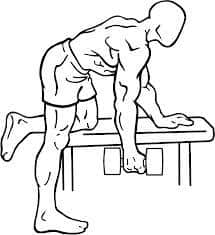 Pick up a dumbbell and stand up straight. Raise the dumbbell to shoulder height while with your other arm you hold on to a fixed surface, or place the other hand on your hip for balance. Extend your lifting arm over your head so that your whole arm is perpendicular to the floor and next to your head. Rotate the palm of your hand so that it's facing forward and your little finger is facing the ceiling. This will be your starting position. Inhale as you slowly lower the dumbbell behind your head while keeping your upper arm stationary. Using your triceps, exhale as you return the dumbbell to the starting position.
Pick up a dumbbell and stand up straight. Raise the dumbbell to shoulder height while with your other arm you hold on to a fixed surface, or place the other hand on your hip for balance. Extend your lifting arm over your head so that your whole arm is perpendicular to the floor and next to your head. Rotate the palm of your hand so that it's facing forward and your little finger is facing the ceiling. This will be your starting position. Inhale as you slowly lower the dumbbell behind your head while keeping your upper arm stationary. Using your triceps, exhale as you return the dumbbell to the starting position.
Lying triceps extension
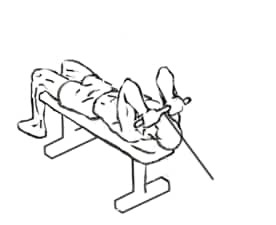 Lie on a flat bench holding a straight barbell with a medium overhand (pronated) grip. Raise the barbell in front of you and above the forehead at arm's length. This is your starting position. Inhale as you slowly lower the weight until the bar almost touches your forehead, keeping your upper arms and elbows stationary. Then exhale as you use your triceps to return the weight to the starting position.
Lie on a flat bench holding a straight barbell with a medium overhand (pronated) grip. Raise the barbell in front of you and above the forehead at arm's length. This is your starting position. Inhale as you slowly lower the weight until the bar almost touches your forehead, keeping your upper arms and elbows stationary. Then exhale as you use your triceps to return the weight to the starting position.
Triceps cable extensions
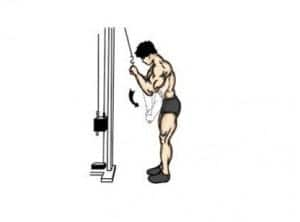 Attach a straight or angled bar to a high pulley and grab the bar with an overhand grip, your hands about shoulder width apart. Stand upright, leaning forward very slightly. Your upper arms should be close to your body and perpendicular to the floor. This is your starting position. Using your triceps, exhale as you push the bar down until your arms are fully extended. Your upper arms should always remain stationary while your forearms move. After holding for a brief pause in the contracted position, inhale and slowly bring the bar up to the starting position.
Attach a straight or angled bar to a high pulley and grab the bar with an overhand grip, your hands about shoulder width apart. Stand upright, leaning forward very slightly. Your upper arms should be close to your body and perpendicular to the floor. This is your starting position. Using your triceps, exhale as you push the bar down until your arms are fully extended. Your upper arms should always remain stationary while your forearms move. After holding for a brief pause in the contracted position, inhale and slowly bring the bar up to the starting position.
Overhead cable extensions
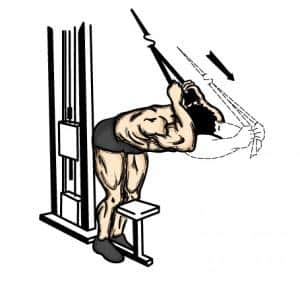 Attach a cable curl bar or a rope to the top pulley of a cable pulley machine. Facing away from the machine, grasp the attachment with both hands and lean forward, pulling your hands directly above your head. Your elbows should be close to your head while your upper arms are perpendicular to the floor with your knuckles aimed at the ceiling. This will be your starting position. Exhale as you slowly extend your arms until your hands are directly in front of your face while keeping your upper arms stationary. Once your arms are extended, inhale as you return to the starting position until your triceps are fully stretched.
Attach a cable curl bar or a rope to the top pulley of a cable pulley machine. Facing away from the machine, grasp the attachment with both hands and lean forward, pulling your hands directly above your head. Your elbows should be close to your head while your upper arms are perpendicular to the floor with your knuckles aimed at the ceiling. This will be your starting position. Exhale as you slowly extend your arms until your hands are directly in front of your face while keeping your upper arms stationary. Once your arms are extended, inhale as you return to the starting position until your triceps are fully stretched.
Close-grip bench press
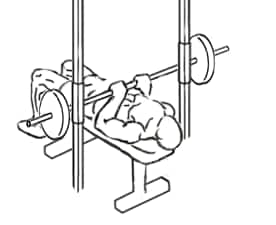 This exercise is similar to the normal bench press but the close-grip makes it an exercise which targets your triceps more than your chest. Lie on bench and grasp the bar with a narrow grip (arms six inches apart). Lower the weight to your chest with your elbows close to your body and then push the barbell up until your arms are completely straight. Make sure you've a strong grip while doing this exercise and don't let your wrists bend.
This exercise is similar to the normal bench press but the close-grip makes it an exercise which targets your triceps more than your chest. Lie on bench and grasp the bar with a narrow grip (arms six inches apart). Lower the weight to your chest with your elbows close to your body and then push the barbell up until your arms are completely straight. Make sure you've a strong grip while doing this exercise and don't let your wrists bend.
Exercises for forearms
Reverse barbell curls
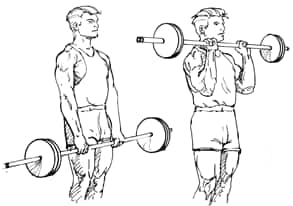 Stand straight with your legs as wide as you hold a shoulder-wide grip with palms facing down. With your elbows side by side raise the barbell as high as you can and then lower until your arms are fully extended. This exercise can also be done while sitting down. The thing to keep in mind is that you should always be in control of the motion without which you could injure your wrists or damage your shoulders.
Stand straight with your legs as wide as you hold a shoulder-wide grip with palms facing down. With your elbows side by side raise the barbell as high as you can and then lower until your arms are fully extended. This exercise can also be done while sitting down. The thing to keep in mind is that you should always be in control of the motion without which you could injure your wrists or damage your shoulders.
Abdomen muscles
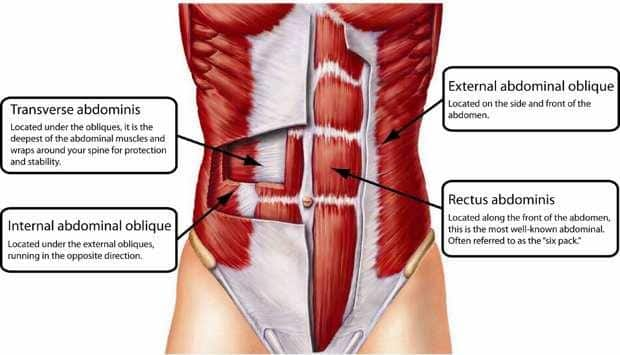 The abs is the defining muscle of our times or so it seems. Everyone's obsessed with flat abs and we can't even seem to have movies without the cast sporting rock hard abs with paeans written about how hard the actors worked to get them. You'd think that getting flat abs was the route to inner peace and nirvana! Putting all the six-pack hype aside, the abdomen muscles together comprise the core muscles, muscles that
The abs is the defining muscle of our times or so it seems. Everyone's obsessed with flat abs and we can't even seem to have movies without the cast sporting rock hard abs with paeans written about how hard the actors worked to get them. You'd think that getting flat abs was the route to inner peace and nirvana! Putting all the six-pack hype aside, the abdomen muscles together comprise the core muscles, muscles that
The abs are however far more important than just an aesthetically-pleasing look, they actually hold up your entire structure. They comprise transverse abdominal, internal obliques, external obliques and rectus abdominis. What these muscles do:
- The transversus abdominis is the deepest muscle and it has a tremendous effect on body posture as it supports the spine.
- The internal obliques are on the sides and slightly less deep and helps in rotation, bending and supporting the spine.
- The external obliques are one both sides of the torso and also helps in rotation, bending and supporting.
- The rectus abdominis is the visible abdominal muscle in the front and is the least important (yes you read it right) of all the muscles. It's the one responsible for the six-pack look and its main purpose is to provide body posture.
We must warn you that no matter how many crunches or other abs exercises you do, you won't have flat abs without losing body fat. Everyone essentially has six-pack abs, all you have to do is remove the layer of fat covering it and for that you need to follow a proper diet, exercise and cardio regime.
Abdominal crunch
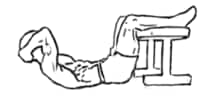 Lie down flat on your back on the floor. Bend your knees. For some variation, you could also keep your legs on an exercise ball or a bench. Put your arms around your chest or behind your head. Now raise your head till your shoulder blades are two to three inches off the ground. Make sure your lower back isn't raised. Repeat for 15-20 times and try and do three sets. If you find it's too easy, try doing it on a declined bench or by adding a weight to your chest.
Lie down flat on your back on the floor. Bend your knees. For some variation, you could also keep your legs on an exercise ball or a bench. Put your arms around your chest or behind your head. Now raise your head till your shoulder blades are two to three inches off the ground. Make sure your lower back isn't raised. Repeat for 15-20 times and try and do three sets. If you find it's too easy, try doing it on a declined bench or by adding a weight to your chest.
Leg raise
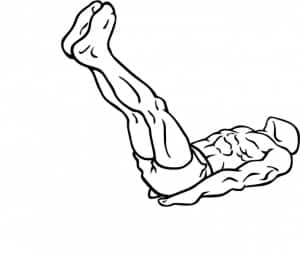 Simply lie down flat on your back and bend your knees. Slowly lift up your legs from your hips and bring your knees level with your chest while keeping your soles upward. Bring your leg back to the starting position but keep in mind that it shouldn't touch the floor. Repeat this movement 20 times and do three sets.
Simply lie down flat on your back and bend your knees. Slowly lift up your legs from your hips and bring your knees level with your chest while keeping your soles upward. Bring your leg back to the starting position but keep in mind that it shouldn't touch the floor. Repeat this movement 20 times and do three sets.
Plank
 Get down in a prone position on the floor similar to the way you'd do for a push-up. Instead of your palms, use your forearms to support your weight. Make sure your arms are bent and below the shoulders. Keep your back straight and hold this position as long as possible. Try and do at least three sets of 30 seconds each.
Get down in a prone position on the floor similar to the way you'd do for a push-up. Instead of your palms, use your forearms to support your weight. Make sure your arms are bent and below the shoulders. Keep your back straight and hold this position as long as possible. Try and do at least three sets of 30 seconds each.
Wood chop
Named after the movement woodcutters make to chop wood this exercise works your abs, shoulders and obliques. It can be done using a dumbbell, the cable pulley machine or a medicine ball. Stand straight while holding a medicine ball. Keep your legs straight and feet hip-width apart. Twist from the waist towards the left with your arms overhead. Hold the ball over your head diagonally upright on the left, twist your torso towards the right and lower your arms in a diagonal fashion across the body and bring it down towards your right foot. You should bend your knees while doing so. Reverse the movement to get back to the starting position for one complete rep. Perform at least 15 reps on one side and then switch sides. Repeat this movement on both sides for at least three sets.
Hanging leg raise
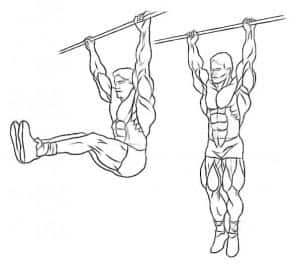 The hanging leg raise is usually done by holding a pull-up bar or using abs straps.
The hanging leg raise is usually done by holding a pull-up bar or using abs straps.
Get up on a stool and hold the pull-up bar. If you find it difficult to grip the pull-up bar properly and balance your bodyweight, use abs straps. After you suspend yourself, slowly raise your knee until they're perpendicular to the ground and then straighten your legs. This entire movement is one rep. Repeat for 15-20 times and do three sets.
Lower body
For some reason, the lower body is often ignored when it comes to weight training and that's a horrible thing. Lower body muscles are significantly bigger than upper body muscle and need to be worked accordingly. They consist mainly of quadriceps (quads), glutes (gluteus maximus muscle), hamstrings and calves.
Glutes Glutes are one of the biggest muscles present in the body. They help extend and rotate our hip and stabilise our pelvis.
Quadriceps Another set of big muscles it helps us flex our thighs and hips and extend our leg and knee.
Hamstrings - Helps movement in the lower body through hip and allows knee flexing and stabilises the pelvis and hips.
Calves The calf muscles main purpose is to help you lift the heels.
Squats
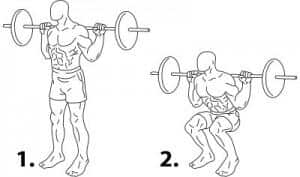 Set a barbell on a rack that best matches your height. Once it is loaded with your desired weight, step under the barbell and place the back of your shoulders under it. Lift the barbell from the rack by simultaneously pushing with your legs and straightening your torso. Step away from the rack and position your legs shoulder width apart with your toes slightly pointed out. This will be your starting position. Inhale as you slowly lower the bar, sitting back with your hips as though you were going to sit on a chair. Maintain the arch in your back. Continue lowering the weight until your hips and knees form a line parallel to the floor. Exhale as you lift the bar to the starting position, leading the movement with your head.
Set a barbell on a rack that best matches your height. Once it is loaded with your desired weight, step under the barbell and place the back of your shoulders under it. Lift the barbell from the rack by simultaneously pushing with your legs and straightening your torso. Step away from the rack and position your legs shoulder width apart with your toes slightly pointed out. This will be your starting position. Inhale as you slowly lower the bar, sitting back with your hips as though you were going to sit on a chair. Maintain the arch in your back. Continue lowering the weight until your hips and knees form a line parallel to the floor. Exhale as you lift the bar to the starting position, leading the movement with your head.
Standing Calf Raises
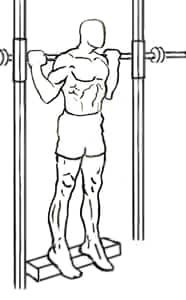 Place your shoulders under the pads of a standing calf press machine and position your toes facing forward. The balls of your feet should be secured on top of the block with your heels extending off of it. Push the lever up by extending your hips and knees until you can stand up straight. This will be your starting position. Now exhale as you raise your heels by extending your ankles as high as possible while flexing your calves. Hold the contracted position for a brief moment, then inhale and slowly lower yourself back to the starting position.
Place your shoulders under the pads of a standing calf press machine and position your toes facing forward. The balls of your feet should be secured on top of the block with your heels extending off of it. Push the lever up by extending your hips and knees until you can stand up straight. This will be your starting position. Now exhale as you raise your heels by extending your ankles as high as possible while flexing your calves. Hold the contracted position for a brief moment, then inhale and slowly lower yourself back to the starting position.
Trainer Tip: Your knees should always keep a slight bend and should never be locked.
Seated Calf Raises
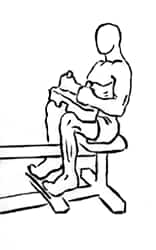 Sit down on a seated calf press machine and place your toes on the lower portion of the platform with your heels extending off it. Place your lower thighs under the lever pad, adjusting the pad to fit snugly against your thighs. Place your hands on top of the lever pad to prevent it from slipping forward. Lift the lever slightly by pushing your heels up and release the safety bar. Inhale as you slowly lower your heels by bending your ankles until your calves are fully stretched. This will be your starting position. Exhale as you raise your heels by extending your ankles as high as possible while contracting your calves. Hold the top contraction for a brief moment and then slowly return to the starting position.
Sit down on a seated calf press machine and place your toes on the lower portion of the platform with your heels extending off it. Place your lower thighs under the lever pad, adjusting the pad to fit snugly against your thighs. Place your hands on top of the lever pad to prevent it from slipping forward. Lift the lever slightly by pushing your heels up and release the safety bar. Inhale as you slowly lower your heels by bending your ankles until your calves are fully stretched. This will be your starting position. Exhale as you raise your heels by extending your ankles as high as possible while contracting your calves. Hold the top contraction for a brief moment and then slowly return to the starting position.
Leg Extensions
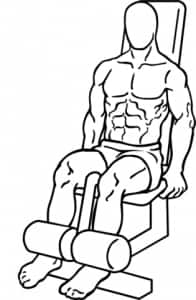 Choose your weight and sit on a leg extension machine with your legs under the pad, your hands holding the sidebars. This will be your starting position. Make sure your legs form a 90-degree angle between the lower and upper leg. Using your quadriceps, exhale and extend your legs while the rest of your body remains stationary on the seat. Pause a second in the contracted position, then inhale as you slowly lower the weight back to the original position, stopping right before the weight load touches the weight stack.
Choose your weight and sit on a leg extension machine with your legs under the pad, your hands holding the sidebars. This will be your starting position. Make sure your legs form a 90-degree angle between the lower and upper leg. Using your quadriceps, exhale and extend your legs while the rest of your body remains stationary on the seat. Pause a second in the contracted position, then inhale as you slowly lower the weight back to the original position, stopping right before the weight load touches the weight stack.
Lying Leg Curls
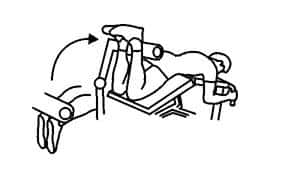 Adjust a leg curl machine to fit your height and lie facedown on it. The pad of the lever should be on the back of your legs, a couple inches below the fullest part of your calves. Keep your torso flat on the bench and ensure that your legs are fully stretched. This will be your starting position. Exhale as you curl your legs up as far as possible without lifting your upper legs from the pad. Once you reach the fully contracted position, hold for a brief moment, then inhale and bring the legs back to the starting position.
Adjust a leg curl machine to fit your height and lie facedown on it. The pad of the lever should be on the back of your legs, a couple inches below the fullest part of your calves. Keep your torso flat on the bench and ensure that your legs are fully stretched. This will be your starting position. Exhale as you curl your legs up as far as possible without lifting your upper legs from the pad. Once you reach the fully contracted position, hold for a brief moment, then inhale and bring the legs back to the starting position.
Leg Press
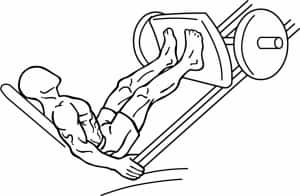 Sit down at a leg press machine and place your feet on the platform directly in front of you shoulder width apart. Lower the safety bar holding the weighted platform in place and press the platform up until your legs are almost fully extended in front of you; do not lock your knees. This will be your starting position. Inhale as you slowly lower the platform until your upper and lower legs form a 90-degree angle. Driving mainly though the heel of the foot, exhale as you push the platform back to the starting position.
Sit down at a leg press machine and place your feet on the platform directly in front of you shoulder width apart. Lower the safety bar holding the weighted platform in place and press the platform up until your legs are almost fully extended in front of you; do not lock your knees. This will be your starting position. Inhale as you slowly lower the platform until your upper and lower legs form a 90-degree angle. Driving mainly though the heel of the foot, exhale as you push the platform back to the starting position.
Picture Sources: Commons Wikipedia, photos.com
Acknowledgement: A special thanks to Kris Gethin for allowing us to publish excerpts from his book The Bodybuilding.com Guide to Your Best Body. Many of the exercises mentioned here are from his book.
For more articles on Fitness check out our Fitness Section and for videos check out our YouTube Channel. Don't miss out on the latest updates. Follow us on Facebook, Twitter and Google Plus.


